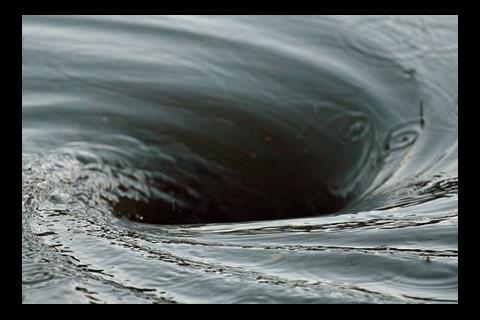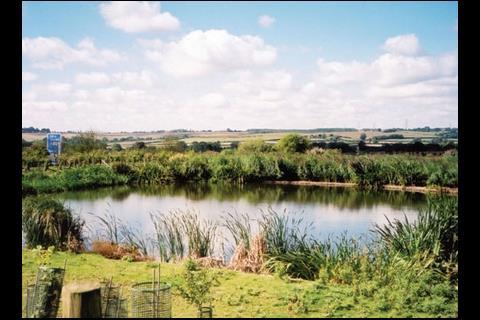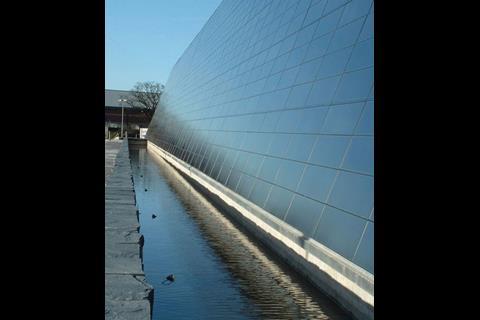Water conservation is often given a low priority in sustainability strategies, but in areas where the water supply is under pressure from development, it may provide relief. Simon Rawlinson of Davis Langdon examines the options and their costs
01 — Introduction
Practical measures to manage water consumption include metering, low-consumption sanitary fittings and controls, sustainable urban drainage systems (SUDS), rainwater harvesting and greywater recycling.
Because of the ready availability of low-cost, high-quality water in the UK, management of water consumption has not demanded the same attention as other sustainability initiatives. But for housing development in low-rainfall areas, water management is increasingly finding its way onto the planning agenda.
For occupiers with large sites and lots of roofscape, it can provide a readily achievable and high-profile sustainability goal.
Water is our most important utility, yet security of supply is almost taken for granted. Investment in infrastructure lags significantly behind the required rate of replacement, resulting in a significant waste in water through the distribution network.
Although the water utility companies are investing more in upgrading the infrastructure, the relatively low cost of water in the UK, capped capital investment and the absence of compulsory metering mean there is little incentive for individual developers or occupiers to reduce water consumption.
By contrast, in countries such as Germany and Australia, where extensive ground water pollution and low rainfall have limited supply, water management means big business.
Trends suggest that per capita water use will continue to increase unless positive management steps are taken.
In areas such as south-east England, where pressure on the water supply already causes problems, there are plans to construct a further 580,000 households by 2026, putting even greater strain on the resources and infrastructure.
Given these twin pressures, water management is gradually rising up the development agenda.
EcoHomes assessments illustrate the relative importance given to water consumption. Water contributes a maximum of 10 points to the 100-point scale – lower than materials, transport and ecology. Indeed, there is currently no standard for water efficiency in the Building Regulations.
This picture is expected to change. The communities department is consulting on possible changes to the Building Regulations.
It also intends to introduce progressive targets in the Code for Sustainable Homes that require consumption to be cut from level one and will require active water capture and recycling measures to meet targets from level five onwards.
02 — Water management systems
Meters Water metering is not compulsory in the UK, but Defra is consulting on the introduction of compulsory metering in “water stress areas”. The areas cover 19 million people living mostly in south-east England. Water meters are installed free by the local supply company.
The argument for compulsory metering is that measurement facilitates water management and encourages consumers to save water.
Arguments against include the risk that consumers could suffer water poverty and, paradoxically, the fact that water costs too little for metering to be an effective management incentive.
Low-flush toilets The flushing of toilets accounts for more than 30% of domestic water use. Low-flush toilets are mandatory in new installations under the Water Supply (Water Fittings) Regulations 1999. Compared with standard toilets, they reduce water use through flushing by 35%.
Ultra-low-flush toilets, typically operating on a flush of 4.5 litres compared with a dual flush of 6.4 litres, can reduce consumption by a further 15%.
The list price cost premium for an ultra-low-flush toilet is about £150.
These devices also qualify for enhanced capital allowances (ECAs) via the water technology list.
Low-water or waterless urinals Urinals operated without proximity sensors flush every 20 minutes, every day, all day. Operated with sensors, flushes can be reduced by 50%. Low-water urinals use a retrofit cartridge lined with bacteria and enzymes that deal with odours between flushes and can reduce the number of flushes to 10 a day. Each cartridge costs between £40 and £60 and needs to be replaced quarterly.
Waterless urinals typically use low-density oils to provide a seal against odours. Costs are typically lower than conventionally plumbed urinals because no water supply or cistern is required. However, they also have costs in use related to replacement cartridges.
Water conservation fittings Options include spray taps, low-flow shower heads and so on. In public buildings, sensor-controlled taps are the best option for reducing consumption as they easily meet Disability Discrimination Act requirements. Spray taps cost about £5 extra. Battery-operated sensor-controlled taps cost between £250 and £300, while mains-supplied systems can cost as much as £500.
SUDS Although not strictly a water management measure, sustainable urban drainage systems provide plenty of opportunities for rainwater capture and storage, as well as mitigating storm run-off and so on. SUDS are described in greater detail in a previous article (31 March 2006, pages 68-70). Key technologies include cellular storage, which can be used as a loadbearing rainwater capture tank as opposed to more conventional tank construction.
Rainwater harvesting Rainwater harvesting involves using some or all of a scheme’s catchment for the capture and storage of rainwater for reuse. Retained water can be used for everything from irrigation to vehicle washing to toilet flushing. Practical issues associated with rainwater harvesting are discussed in greater detail below.
Greywater recycling Greywater recycling is concerned with the capture, treatment, storage and reuse of waste water. Only lightly contaminated water can be used in greywater systems, typically sourced from baths, showers and basins. Water from washing machines, dishwashers and kitchen sinks is considered too contaminated to be used.
Most greywater systems in the UK are used for flushing toilets. Installing them involves complex pipework arrangements, storage and treatment components. By contrast, a simpler approach in Australia based on using greywater for irrigation has become very popular. Practical issues and costs are discussed overleaf.
03 — Factors affecting the viability of water management installations
Water costs in the UK are low compared with other European countries. The current regulatory scheme, originally directed by Ofwat, will continue until 2010 and prices will increase at a rate below retail price inflation.
As costs are low and will remain so in the foreseeable future, there are not the same economic drivers for conservation as there
are affecting large-scale energy users. What’s more, given the significant savings that can be achieved using simple measures such as metering and low-flush toilets, the motivation to invest in high-impact measures such as rainwater capture or greywater recycling has to come from non-financial factors.
Chief among these are planning requirements, often driven by local constraints on water supply or the cost of upgrading the local infrastructure. They could also be specified as part of an attempt to meet an enhanced BREEAM or EcoHomes standard.
Given the relatively low value of water, payback periods on rainwater harvesting and greywater recycling systems are long – typically 20 years or more. Although rainwater systems are relatively durable, greywater systems have a useable life of about 15 years because of the need to replace pumps and filters and the corrosive nature of greywater.
Larger communal systems, which benefit from economies of scale in terms of storage, treatment and pumping, are likely to have a shorter payback period.
Once an economic and sustainable case for water capture installation has been made, practical issues concerning its incorporation into a development need to be resolved. The main issues to be considered include:
- Access to a sufficiently large catchment or supply of greywater to meet expected demand
- The impact of small-scale water economy measures based on availability of greywater, demand for flushing water and so on
- Continuing availability of greywater to make an impact on use for flushing as a result of reductions in other water use
- User acceptance of greywater
- Availability of space for storage facilities.
The final viability issue associated with greywater systems is operations. Unlike most other water management systems, greywater systems will require regular maintenance.
Most systems are designed to operate in fail-safe mode, whereby the supply of greywater is cut off if filtering or treatment operations fail. Unless systems are regularly tested and maintained, the risk is they could switch into fail-safe mode, making no contribution to the reduction of consumption.
On this basis, schemes promoting water conservation and the use of rainwater are finding favour with clients, while greywater systems remain marginal in most cases. However, for high-density town-centre housing, where water consumption is high and there are limited opportunities for rainwater harvesting in sufficient quantities to meet demand, greywater can make an effective contribution to reduction in water use.
04 — Water capture and storage systems: general principles
The key issues for rainwater capture and greywater storage systems are:
- Source
- Treatment methods
- Storage
- Collection and distribution pipework.
Treatment is required to control physical, microbiological and chemical quality. Physical quality is maintained by removing solids by filtering, which might affect colour, odour and clarity (turbidity). The presence of solids can also affect the operation of pumps and filters, and provides a food source that encourages bacterial growth.
Biological treatments remove nutrients from the water, and disinfection kills all micro-organisms by either chemical or physical means.
The extent of microbiological treatments depends on the nature of the source water and its intended use. Rainwater needs less extensive treatment, but greywater can be loaded with nutrients and organisms. It begins to decay quickly after capture.
If there is any chance of human contact, even as a flushing medium, then extensive disinfection is required, aimed at a wide range of potentially harmful organisms. Chemical treatment is also needed to maintain an acceptable pH level so that disinfectant processes are fully effective.
Treatment processes are associated with most of the operation and maintenance requirements, together with consumables such as chemicals. As a result, greywater recycling involves higher operational costs than rainwater-based systems.
Storage requirements are calculated with regard to the level of consumption and the frequency of supply. Rainwater tanks are sized to provide a continuous supply between rainfalls, typically 12-20 days. The relationship between supply and use in greywater systems is better balanced.
The ability to store water is also an issue: greywater must be disposed of on a three to four-day cycle whereas rainwater can be stored for longer periods.
The collection and distribution pipework is typically made of plastic to withstand the corrosive effects of greywater. However, some of the disinfectants used in systems also have a corrosive effect.
The key issue associated with the collection and distribution network involves the avoidance of any risk of contamination of the mains water system. The principal responses to the risks involve backflow protection and, more importantly, clear marking of pipes to ensure that future system modifications don’t result in cross-connection of the systems.
Another consideration in the design of the distribution system is avoiding deadlegs in which stagnant water might collect. Infrequently used facilities, such as guestroom toilets, are better served using mains water.
05 — Special considerations: rainwater capture
Rain provides water that can supply toilets, irrigation systems and appliances such as washing machines and dishwashers. The quality of the water is determined partly by location and also by
the nature of the catchment – for example, exposure to forms of air pollution or potential contamination from bird droppings. Most roof materials are suitable as catchments, as are permeable pavements.
Filtering is a key element of the rainwater capture system. Depending on the end use, several stages may be required to achieve an acceptable level of quality and to protect pumps and other systems from excessive wear. Automated cleaning processes and easy access to the filters for inspection and replacement is vital to ensure the long-term performance of the system.
The design and specification of storage tanks introduces the following issues to be considered:
Tank sizing: determined by a combination of the water requirement, rainfall patterns and the available catchment. The extent of the catchment is determined by downpipe routing or, in SUDS, through the use of impermeable barriers to isolate a section of paving.
Tank location: finding enough space to accommodate a tank that can hold the intended water capacity. This can be a significant issue for communal systems and an underground tank may need to be specified. Underground tanks introduce a range of issues related to loadings, movement, flotation and so on. Construction work surrounding installation will add about 50% to the cost of the system. Underground tanks also need ventilation and must be kept safe from contamination from floodwater in the event of severe weather. As a result, they may also require conspicuous above-ground access.
Access: providing easy access for inspection and maintenance is important if long-term water quality is to be maintained.
06 — Special considerations: greywater recycling
Greywater is waste water taken from baths, showers and hand basins. It can only be used for toilet flushing and garden irrigation but, even in these uses, a high level of treatment is required.
Sub-surface irrigation systems that avoid any risk of direct human contact with greywater enable the use of slightly simpler systems producing lower-quality recycled water.
Although subjected to very intensive treatments, greywater will never be clear like tapwater, so it is better suited to domestic rather than public applications because users can make a positive choice to use the system. There is also a better balance between supply and demand for greywater in houses than in commercial or public buildings, where little water is available for recycling and management measures such as spray taps can make a greater impact on consumption.
Filtering and treatment are the key issues for greywater systems, particularly in communal systems. The treatments have to be able to cope with worst-case scenarios, such as accidental faecal contamination, and will use chemicals such as bromine, chlorine or ozone or, in some cases, systems based on ultraviolet light.
As all systems are designed on a fail-safe basis, it is essential to have effective monitoring systems and easy access for cleaning and maintenance if the full benefit of a greywater system is to be gained.






























No comments yet